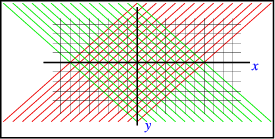6.1: Antecedentes de la solución de D'Alembert
- Page ID
- 113744
He argumentado antes que no suele ser útil estudiar la solución general de una ecuación diferencial parcial. Como cualquier declaración tan radical necesita ser calificada, ya que hay algunas excepciones. Una de ellas es la ecuación de onda unidimensional
\[\dfrac{\partial^2}{\partial x^2} u(x,t) - \frac{1}{c^2} \dfrac{\partial^2}{\partial t^2} u(x,t) = 0, \nonumber \]que tiene una solución general, debido al matemático francés d'Alembert.
El motivo de esta solución se hace evidente cuando consideramos la física del problema: La ecuación de onda describe ondas que se propagan con la velocidad\(c\) (la velocidad del sonido, o la luz, o lo que sea). Así, cualquier perturbación al medio unidimensional se propagará ya sea hacia la derecha o hacia la izquierda con tal velocidad. Esto significa que esperaríamos que las soluciones se propaguen a lo largo de las características\(x\pm ct=\text{constant}\), como se ve en la Figura\(\PageIndex{1}\).



